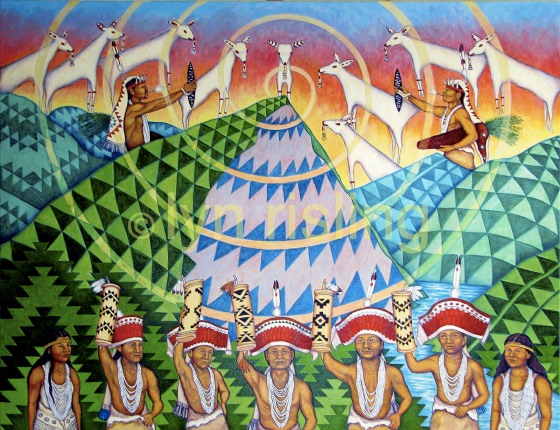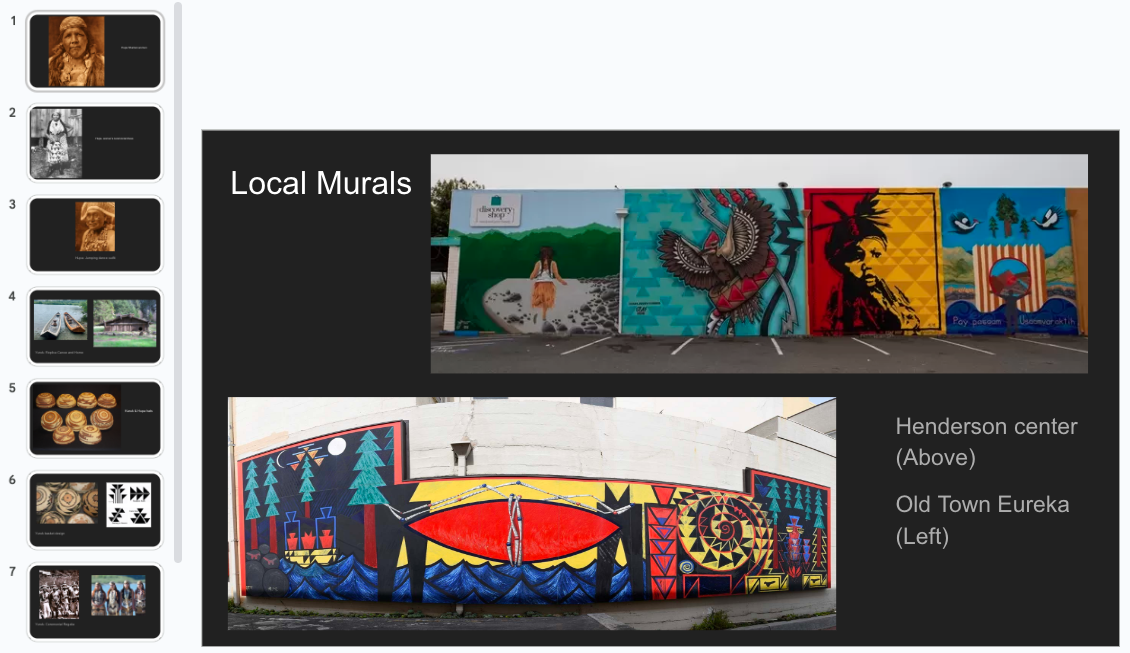Analyzing Symbolism in Art with a Local Artist
Focus here: Artist Lyn Risling
Lesson Overview and Context
In this lesson students will be looking at art created by indigenous artist local to our community named Lyn Risling. In this lesson, students will discuss Risling’s use of symbolism and connect symbols in her art to historical artifacts within the Yurok, Karuk, and Hupa cultures.
This lesson is an example of how you might create a lesson using the work of a local artist as well as a lesson you may use to analyze symbolism in Lyn Risling’s work.

Learning Objectives
Students will be able to identify symbols in art and relate them to their historical context. Students will then be able to create their own art using their understanding of symbolism.
Related California Standards
- 2.VA:Cn10- Create works of art about events in home, school, or community life.
- 4.VA:Cn10- Create works of art that reflect community cultural traditions.
- 4.VA:Re8- Interpret art by referring to contextual information and analyzing relevant subject matter, characteristics of form, and use of media.
- 4.VA:RE7.2- Analyze components in visual imagery that convey messages.
- 5.VA:Re8- Interpret art by analyzing characteristics of form and structure, contextual information, subject matter, visual elements, and use of media to identify ideas and mood conveyed.
- 5.VA:Re7.2- Identify and analyze cultural associations suggested by visual imagery.
- 6.VA:Cn10- Generate a collection of ideas reflecting current interests and concerns that could be investigated in artmaking.
Materials/Preparation
- Device to project images onto a large-screen display
- Lined paper (1 per student)
- Blank white paper for art (1 per student)
- Pencils
- Coloring supplies of choice
- Images to share:
- Yurok Basket Tray Image
- Yurok Twined Lidded Basket Image
- “Renewal” Mural at Cal Poly Humboldt Image
- Yurok Canoe Image
- Hupa Doll
Step-by-Step Instructional Plan
See, Think, Wonder
Without introducing the name of the art, display the image of World Renewal by Lyn Risling for the class to see. Use a See, Think, Wonder process: Have students partition a piece of paper into three sections. Give students a few minutes to answer the following in each section.
- Section one- “What do you see?”
- Section two- “What do you think?”
- Section three- “What do you wonder?”
Hold a discussion where students may share their ideas with the whole class.
Introduction of the work of art
Introduce the image as World Renewal, a painting by Lyn Risling. Explain that this painting is located at Cal Poly Humboldt’s Goudi’ni Native American Gallery. Risling’s art is strongly connected to the cultures of her grandparents, of the Karuk, Yurok, and Hupa peoples of the Klamath and Trinity Rivers in Northern California.
Share the following slides and ask students to study each image.
- Some students may have cultural connections to these local tribes. These slides may be used as a discussion point for students who would like to share prior knowledge with the class.
Ask students to turn and talk with a partner about what similarities they saw between the pictures in the slides and the original painting. Give students a minute to share with partners before having a class discussion for students to share what they noticed whole group.
- Students may notice the geometric designs, White deerskin heads, ceremonial outfits, etc. Students may also notice that some of the photos were taken more recently. It is important to note although these tribes have historical richness, they are still very much alive today.
Discuss the following. “What is symbolism?” “What is the purpose of symbolism in art?” “How has the artist Lyn Risling used symbolism in her art?”
- A symbol is a mark, sign, or word that indicates, signifies, or is understood as representing an idea, object, or relationship. Symbols allow people to go beyond what is known or seen by creating linkages between otherwise very different concepts and experiences. Symbolism in art can be seen in shapes, colors, lines, textures, space, etc.
Introduce more work by this artist
Display some more examples of Lyn Risling’s art. Risling takes inspiration from stories, her own life experiences, and cultural traditions and ceremonies.
Have students share what other pieces of symbolism they see in her art. (Bright and bold colors, borders with geometric shapes used on baskets, items from nature, animals like the coyote, spirals, words). Ask students if they can relate some of the images to their own lives. Have they seen any salmon, deer, or indigenous baskets/ regalia within their own lives and surrounding community?
Make connections to their own lives
Students will now be making their own art piece that represents important parts of their own lives. Brainstorm: On the back of the See, Think, Wonder paper, instruct students to write a list of important identifiers in their own lives. Culture, hobbies, family, likes, interests, faith, friends, and community.
After students have completed a good sized list, ask them to circle a few (3-5) that stick out as the most important to them. Then for each circled word have students write a few ideas that describe or symbolize that part of their life ( For example, maybe they have five members of their family so they write the number 5, love, and the names of each of their siblings. Maybe they’re on a basketball team, so they write basketball, net, jersey, and the color and name of their team.)
Create and present their own art
Students will now be turning their ideas into art! Hand out a clean sheet of white paper to each student. Explain that they will be taking inspiration from their brainstorming sheet to help them create a symbolic art piece of their own. They may choose to flip the paper portrait or landscape style before sketching some of the symbols they believe best represent their lives. Make sure to have coloring supplies available to students.
Wrap up: Allow students time to present their art. This can be done in partners, groups, or as a class gallery walk.
Extension Ideas
- Have students type an explanation paragraph or essay to be displayed with their art.
- Have students complete See, Think, Wonder charts for their classmates’ art.
- Learn more about local indigenous tribes.
Related Resources
- Lyn Risling’s website
- Look to Your Culture: Artist Lyn Risling shares her journey from the Humboldt Insider, Fall/Winter 2022
- Clarke Historical Museum in Eureka, California
- Native Knowledge 360° by the Smithsonian’s National Museum of the American Indian


